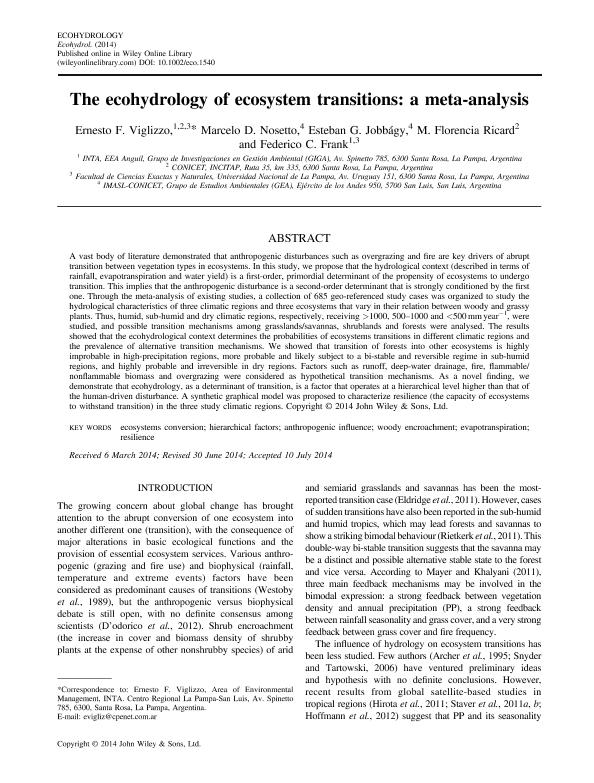Artículo
The ecohydrology of ecosystem transitions: a meta-analysis
Viglizzo, Ernesto Francisco ; Nosetto, Marcelo Daniel
; Nosetto, Marcelo Daniel ; Jobbagy Gampel, Esteban Gabriel
; Jobbagy Gampel, Esteban Gabriel ; Ricard, Maria Florencia
; Ricard, Maria Florencia ; Frank, Federico C.
; Frank, Federico C.
 ; Nosetto, Marcelo Daniel
; Nosetto, Marcelo Daniel ; Jobbagy Gampel, Esteban Gabriel
; Jobbagy Gampel, Esteban Gabriel ; Ricard, Maria Florencia
; Ricard, Maria Florencia ; Frank, Federico C.
; Frank, Federico C.
Fecha de publicación:
06/2014
Editorial:
Wiley
Revista:
Ecohydrology
ISSN:
1936-0584
Idioma:
Inglés
Tipo de recurso:
Artículo publicado
Clasificación temática:
Resumen
A vast body of literature demonstrated that anthropogenic disturbances such as overgrazing and fire are key drivers of abrupt transition between vegetation types in ecosystems. In this study, we propose that the hydrological context (described in terms of rainfall, evapotranspiration and water yield) is a first-order, primordial determinant of the propensity of ecosystems to undergo transition. This implies that the anthropogenic disturbance is a second-order determinant that is strongly conditioned by the first one. Through the meta-analysis of existing studies, a collection of 685 geo-referenced study cases was organized to study the hydrological characteristics of three climatic regions and three ecosystems that vary in their relation between woody and grassy plants. Thus, humid, sub-humid and dry climatic regions, respectively, receiving >1000, 500?1000 and <500mmyear1, were studied, and possible transition mechanisms among grasslands/savannas, shrublands and forests were analysed. The results showed that the ecohydrological context determines the probabilities of ecosystems transitions in different climatic regions and the prevalence of alternative transition mechanisms. We showed that transition of forests into other ecosystems is highly improbable in high-precipitation regions, more probable and likely subject to a bi-stable and reversible regime in sub-humid regions, and highly probable and irreversible in dry regions. Factors such as runoff, deep-water drainage, fire, flammable/ nonflammable biomass and overgrazing were considered as hypothetical transition mechanisms. As a novel finding, we demonstrate that ecohydrology, as a determinant of transition, is a factor that operates at a hierarchical level higher than that of the human-driven disturbance. A synthetic graphical model was proposed to characterize resilience (the capacity of ecosystems to withstand transition) in the three study climatic regions. Copyright © 2014 John Wiley & Sons, Ltd.
Archivos asociados
Licencia
Identificadores
Colecciones
Articulos(IMASL)
Articulos de INST. DE MATEMATICA APLICADA DE SAN LUIS
Articulos de INST. DE MATEMATICA APLICADA DE SAN LUIS
Articulos(INCITAP)
Articulos de INST.D/CS D/L/TIERRA Y AMBIENTALES D/L/PAMPA
Articulos de INST.D/CS D/L/TIERRA Y AMBIENTALES D/L/PAMPA
Citación
Viglizzo, Ernesto Francisco; Nosetto, Marcelo Daniel; Jobbagy Gampel, Esteban Gabriel; Ricard, Maria Florencia; Frank, Federico C.; The ecohydrology of ecosystem transitions: a meta-analysis; Wiley; Ecohydrology; 8; 5; 6-2014; 911-921
Compartir
Altmétricas



